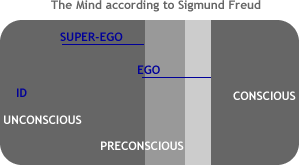Sources:
http://psychology.about.com
Title:
"Comprehensive Text Book of Psychiatry"
A. M. Freedman, M.D.
H.I. Kaplan, M.D.
The Williams & Wilkins Company. 1967 Baltimore
Title:
Sigmund Freud
Cinq Lecons sur la psychanalyse suivi de
La contribution a l'histoire du mouvement psychanalytique.
"Five Psychoanalytic
Followed by
Contribution to the history of the Psychoanalytic movement."
Sigmund Freud |
|
First recognition of the significance of dreams:
Today, dreams occupy a central position in psychoanalytic practice and theory and are the subject of expanding research interest. Nevertheless, the value of dream interpretation in psychiatric treatment have not been clearly elucidated.
Freud first became aware of the significance of dreams in therapy when he realized that in the process of free association his patients frequently described their dreams of the night before or of years past. He then discovered that these dreams had a definite meaning, although it was disguised.
Freud's monumental publication in 1900, The Interpretation of Dreams, included much of the data derived from his clinical experience in this area, as well as the insights he acquired by free association for his own dreams. On the basis of these data, he concluded that a dream is the conscious expression of an unconscious fantasy or wish which is not accessible to the individual in waking life.
According to Freud, every dream represents a wish fulfillment. Dreams are representative of the imaginary fulfillment of a wish or impulse in early childhood, before such wishes have been repressed.
The dream images represent the unconscious wishes or thought disguised through symbolization and other distorting mechanisms. Freud has postulated the existence of a "censor" which excluded unconscious wishes during conscious states and which in sleep compelled the transformation of unconscious wishes into the disguised conscious form of the dream as experienced by the sleeper. Freud assumed that this "censor" was in the service of the ego: that is, he considered it as self preservative function which was in accord with his belief that reason and volition presided over these functions. With the development of ego psychology, the activities of the censor, along with the manifestations of repression, displacement, and symbolism in waking life, have been included among those functions of the ego and superego which may lie outside the individual's conscious awareness.
The Interpretation of Dreams led Sigmund Freud to the theory of the mind:
Through The Interpretation of Dreams, Sigmund Freud represented an attempt to divide the mind into three regions called, The unconscious, The Preconscious and The Conscious, which were distinguished from one another by their relationship to consciousness.
Sigmund Freud was convinced to have found the "royal road" to reach the core of our unconscious.
|
*Ego - In psychoanalysis, the division of the psyche (mind, soul) that is conscious, most immediately controls thought and behavior, and is most in touch with external reality.
According to Sigmund FREUD, that part of the personality which functions according to the "reality principle". The ego is without energy, and has to steal its energy from the ID by means of what Freud called "identification". Through identification, the ego is able to fulfill its basic function, which is to act as an intermediary between the Id and the outside world.
|

*ID- The unconscious structure in Sigmund Freud's model of the mind which represents the instinctual force towards immediate gratification of biological drives, such as sex, thirst and hunger.
The Conscious has been described by Freud as a kind of sense organ of attention which operates in close association with the preconscious.
* Sigmund FREUD saw the mind (or the PSYCHE) as having three separate component parts: the conscious, preconscious, and unconscious. Material in the unconscious could never become conscious, but material in the preconscious could occasionally become conscious. The unconscious, Freud saw as containing material which had been repressed for some reason: because it was too traumatic or painful to reach consciousness. This material might consist of memories, fantasies, wishes, dreams, etc. The three structures of the ID, EGO, and superego Freud saw as mapping onto this model. The ego he argued was not always conscious, or even preconscious: Freud found that many of his patients were unaware of how their egos operated to help them to function as social beings. The superego, he argued, spanned the unconscious and the preconscious, while the id was completely unconscious.
|
Sigmund Freud | Freud's Theory of Dreams | Non-Freudian Theory of Dreams
© Sandra Smith 2001-2003. All rights reserved. Updated & Revised: 08/12/2003 © smithwebdesign.com |
